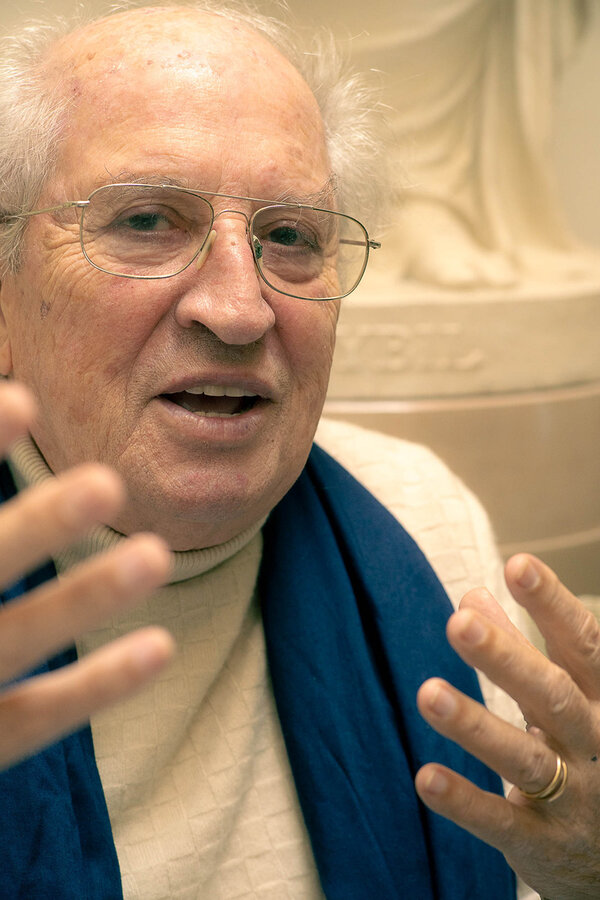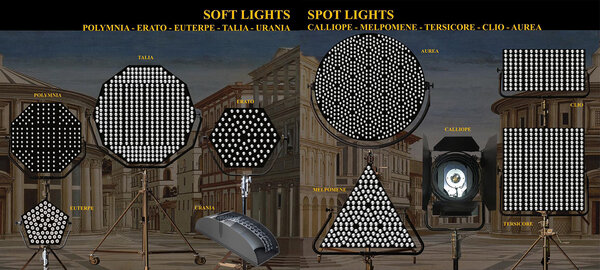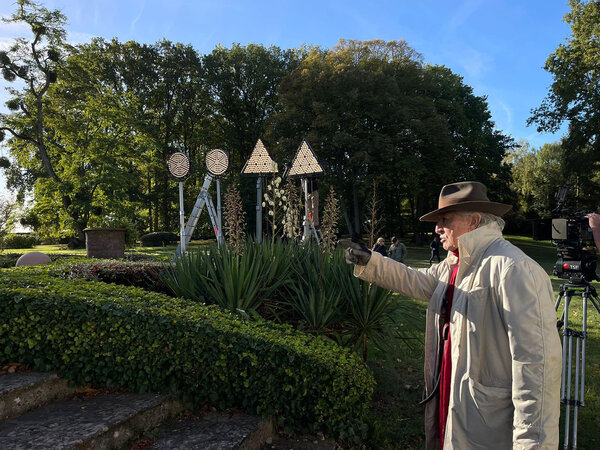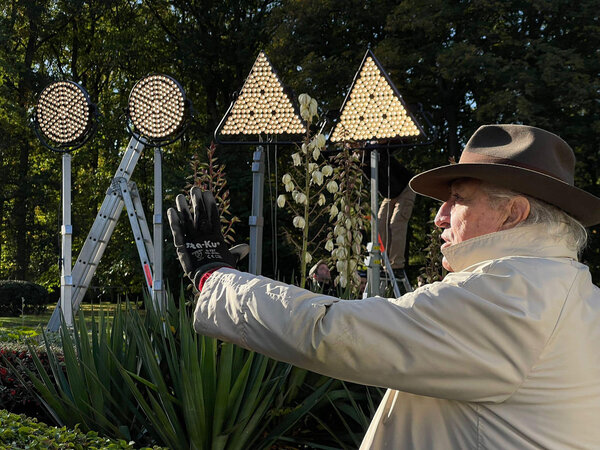Interview with Vittorio Storaro, AIC, ASC, about his view of the profession, his career and his “Muses of Light” spots
Zeus and his Nine DaughtersHow do you choose your films ?
Vittorio Storaro : In my opinion, there must not be any difference between the professional and the person you really are. That’s why I always put my heart, my desires, and my personal trajectory at the same level as the projects I am offered a role on. Whatever your profession, your dreams, your life, your personal situation must always somehow be in symbiosis with what you do. That’s why, from the earliest days of my career, I always took great care to examine each project, and to accept it (or not) because I really felt I was on the same wavelength as the director. For example, on Apocalypse Now, where Francis Ford Coppola asked me to film this story set in the middle of the Vietnam War, it involved both a subject and a context that seemed very far removed from what I’d filmed in the past. Indeed, I’d been making relatively intimate films with lots of shadow and gradients, such as The Conformist or Last Tango in Paris… totally different from a war film ! I was really surprised he asked me to make the film, especially after he’d shot Godfather 1 and 2 with Gordon Willis, which were splendid films. And yet, as I read the screenplay and over the course of several telephone conversations we had, I suddenly perceived the true nature of the film. I remember clearly Francis telling me : "But Vittorio, this isn’t a war film, this is a film about civilization !" And he spoke to me about the deep link with Heart of Darkness, the novel by Joseph Conrad he requested I read immediately. Afterwards, I shared with him my idea of confronting natural light and artificial light on the screen, which would symbolize the confrontation between American forces and those of the colonized country. A tragedy shot in CinemaScope, diametrically opposed to a documentary image, with a universal side that seemed right to me for this film. I felt perfectly at ease in this direction, and it was this same dynamic that allowed us subsequently to overcome the many obstacles that came up in our path. It’s because I identified with the project as a human being that I decided to make this movie. And that’s what I’ve always done on every project.

And the end of the film with Marlon Brando in the shadows was really pretty audacious !
VS : In fact, I’d already shot sequences with lots of contrast in The Conformist. I remember particulary the sequence of The Mith of the Cave, by Plato. I’d had the idea while looking at paintings by Caravaggio. As strange is it might seem, during my nine years of higher education in Photography and Cinematography, no one had ever once spoken to me about him. And yet, to me, he was the first ever Author of cinematography !
Take The Calling of Saint Matthew, for example. It’s a foundational painting in my opinion. After I’d seen it, it sparked everything else. A hunger for culture, knowledge, films, books, paintings, music, etc. etc. And then Francis Ford Coppola had seen The Conformist at a festival in New York. It was thanks to that screening that he called me up to make Apocalypse Now.
What’s an example of a film you’ve turned down ?
VS : When Francis Ford Coppola offered me One From the Heart, in 1979, his initial idea was to film the entire movie not on Film (with very ambitious set changes). The technology of that time got him to consider using one of the first analogic video cameras, as The Mystery of Oberwald, which Michelangelo Antonioni had shot shortly before with Cinematographer Luciano Tovoli, in video and in color for Italian television.
But I’ll admit I wasn’t at all won over by his idea. Indeed, One From the Heart wasn’t intended for TV, but for Film theaters… And the few attempts at transferring video onto a 35mm copy (done for Antonioni’s film) weren’t yet perfected at that time. I told Francis I wouldn’t make the film… Faced with his insistence, I accepted but on condition it be shot on film – in a mixed combination – with Black and White video feedback to enable him to judge the initial result on set. It was definitely at that price that the film is what it is now, as the master video elements would have probably suffered too much in the blow up transfer on 35mm film and the passing of time to be able now to be correctly recopied in digital… Besides these technical details, you have to understand that One From the Heart was a model for new Cinema with several stages of preparation. In the first phase, Francis Ford Coppola, Dean Tavolaris and I, in several meetings realized the entire vision of the film, put on a storyboard that was the basis of Editing with the Actors’ reading of the Screenplay and an initial music by Tom Waits. The second phase, I recorded with a small B/W camera the rehearsals of the actors directed by Francis, which were edited with an already advanced soundtrack.
The third phase, with the sets ready, the costumes almost completed, the lighting fully controlled by a Cinematography Lightboard and the music very advanced, the whole film was recorded in sequence with a small color camera, as a complete technical rehearsal of the whole film.
We projected said rehearsal and figured out between Francis, Dean and myself, what was right and what needed improvement. The fourth phase was the final recording with three 35mm film cameras. Starting with the first scene and sequentially all the scenes of the film, in a few weeks we completed the filming of the film. Using the theory of Theology of Colors to underline the different character of the actors, each one with its own shads of color.

Let’s discuss your new range of spotlights and softlights "The Muses of Light" you’ve developed…
VS : After shooting The Messenger of God, in 2014, with Iranian director Majid Majidi, I took stock of the total overhaul we were heading towards in terms of equipment. This film was a very ambitious project, requiring over a year of preproduction, and as much time for shooting. The shooting in Iran involved extreme temperatures (+50 to -25° C) which had pushed me towards shooting in film (for more reliability from the cameras). For this film, we reconstructed a good part of the cities of Mecca and Medina. I remember that I had three 300kW generators on that nighttime sets, which now seems totally insane to me. When I got back from the film, I had a long discussion with my daughter Francesca, who is an architect, and who was hired to redo the permanent artistic lighting of the Imperial Forum in Rome. In collaboration in that project with her, I discovered the great variety of LED spotlights and softlights that are usually used for architecture, and I suddenly realized that with the demise of film – Technicolor Rome had just closed the laboratory, Kodak their office, – and the Film Industry changed the laboratory and the film cameras in electronic system, I felt that also lighting should change. Very high sensitivity of digital sensors, it was now possible to consider marrying these two worlds. And that’s what we decided to do by developing a series of spotlights, "The Muses of Light".
For me, it was crucial to develop a ground-up concept for this new line of tools, not just take up the old lights and replace the bulbs with LEDs. Taking the geometric form as the starting element, from the narrowest light named Calliope (modeled after the automatic arc from the 1960s) to the broadest light, a circle with a diameter of 1.6meters (the Aurea). Between the two, there are eight models whose form and size are directly inspired by the work of Luca Pacioli, a Renaissance mathematician ("De Divina Proporzione") which influenced Leonardo da Vinci’s own composition of his works on the painting The Last Supper but asked to him to design all the Geometric Form, from the Square to the Circle.
In that period, working with director Carlos Saura in several films meanly based on the Arts of Music, Singing and Dancing, I felt that I need to amplify my knowledge in their Creative Inspirations : The Muses.
So I started study the concept of The Muses, originally conceived in three Arts by Plato were completed in nine Arts by Esiodo, trying to combine the various Geometric Forms with each specific quality of the various Arts. From this idea, unify the concept of Leonardo with Esiodo, that gived at each Art the specific name, we realize “The Muses of Light” : Calliope (The Point) – Melpomene (The Triangle) – Tersicore (The Square) – Clio (The Rectangle) – Polymnia (The Pentagon) - Erato (The Exagon) – Euterpe (The Octagon) – Talia (The Semicircle) - Aurea (The Circle) , this last one, personalIy I invented its name at the “Then Art”, the Cinema, that it feeds itself from the all nine arts : Aurea (the Circle).
These lights are really fantastic. I now only use them on all of my films, such as the one I’m working on now with Woody Allen. Most of the French crew are using them for the first time, and I’ve had excellent feedback from my gaffer Greg Fromentin, who’s very enthusiastic about them – even though I thought he was a bit worried in preproduction asking me : “Vittorio, are you sure you do NOT wont to use any other type of lights ?” – “YES”, was my answer. Their spectral quality is perfect for me and, since they can be adjusted from 2,700 to 6,500K, I can use them in almost any situation. With the sensitivity of current digital sensors, I am able to gain a great freedom on set. Such setups, which would have required several hours of pre-light in the past, are now very simple. You can just plug them into the electricity available on location, where we use very light generators, or even autonomous solutions on battery.
Muses of Lights have :
- Very low power absorved…
- Don’t need gels for CCT control of the whites…
- Don’t need to change lamp anymore…
- Dimmers are not needed…
- They fully flicker free at any camera speed…
- The electronics are modular and remotable up to 50m from the device head…
- The electronics are powered with universal voltage.


Why did you choose bicolored lights when the immense majority of the market has moved towards RGB ?
VS : With Francesca, we chose to remain with bicolored LEDs because we think that projectors that use RGB multichromatic elements don’t attain the quality we expect from whites. When I need a particular color, outside of the TC variations, I add gels as in the past.
What did you do during the pandemic ?
VS : I had a lot of free time, like everyone else ! I took advantage of it to reminisce and write a book about my long collaboration with Bernardo Bertolucci. Simultaneously, I undertook the restoration of the nine films I shot with him, from The Spider’s Stratagem in 1970, to Little Buddha, in 1993, with all the new possible digital technology, that can give me the ability to find the various Chromatic Shades and the right contrasts between light and shadow as close as the original view of each film.
Of course, it was very important to me to preserve that cinematographic heritage, even though I was astonished to realize that none of those films had been really seriously preserved. I mean via the method of "Silver Master Separation", which consists of extracting three black and white film elements from the original color negative, in order to guarantee an optimal preservation of the colors, and a digital version that is as faithful as possible, in function of the state of technology. It’s beyond my understanding that no one in Europe is using this technology, which is being used in the USA by studios. Happily, thanks to the reputation of these films, and the money provided by the Italian Ministry of Culture, I was able to have this done on these films, and I am now fighting for its generalization. In 1996, I asked to Kodak to help me in transfer on that system the nine film that I did with Bertolucci and make an effort on the price of film, and that the labs capable of doing this type of work will play along, too. Kodak helped me and now at the Cinecittà Laboratory in Rome I start from that Silver Master Separation for the visual restoration of all the Bertolucci’s movies.
As soon as the restoration of each film is on a Master HD 4K and 16bit Color is completed, we transfer it to the new HDR (High Dynamic Range) system to complete the whole work in storing the whole series of films with the brand new D.O.T.S (Digital Optical Tape System) by Group 47 of Rob Hummel, that will pick up all film at very low cost and in a small space, preserved for many many years of our future.
Is there a great difference when you transfer film to digital ?
VS : There’s no comparison. You know, on The Conformist, for example, you can’t use the original negative anymore. Starting with the three black and white elements (RGB), you can retain much more color nuance, especially in shadow.
Do you think that with the rise of digital platforms, the days of the movie theater are numbered ?
VS : I’m not sure that seeing a film in a theater is so crucial today. After all, ever since the first cave paintings, and then engraving, painting on wood and canvas… there were so many technological evolutions in the representation of art that that’s, when it comes down to it, what is always at the center of our debates. In a word, only the technology changes, but the ideas don’t. Watching a film on one’s tablet or on one’s LCD screen at home is still watching a film. And filmmakers will always need to tell stories ! Of course, the emotion in a theater, and the collective unconscious, are irreplaceable, but you have to admit that smartphones have profoundly changed the relationship that people – and not just young people – have to images. We have to accept it, and it’s a question of education. Access to images, culture, knowledge, is now practically instant. It’s just that it requires more pugnacity, more motivation, and more time to go past the simplistic summaries that are available everywhere in order to extract the gold you’re in search of…
Is this progress ?
VS : I think that progress can be slowed down or accelerated but, not stopped.
What is certain is that progress does not come from a society that is closed in on itself. Like on a film, collaboration and openness to others are what cause the world to evolve. Look, at the Saint Petersburg Museum, there is a collection of icons from the 9th century to the 17th century. Each is as beautiful as the next. But the art of that long period was frozen, with no change. It was only after the reign of Peter the Great (late 17th century) that things changed. Simply because he opened Russia to the rest of the world and he was nourished by Dutch, French, English and Italian influences… For me, this is the perfect illustration of this collaboration. He brought back ideas and knowledge from his voyage that literally transformed the art and architecture of his country and caused it to advance to a higher level.
What is a movie you saw in a theater that you will remember for the rest of your life ?
VS : 2001, by Kubrick. Of course, it was a concept : 70mm, the scope of the project, the legendary images and the music… But beyond all of that, it was because it’s a story that touched me deeply, my soul, was the concept that places the human being with the Universe, the philosopher Giordano Bruno said : “We live not only in an Universe but in an infinite number of Univers”… the Relationship between Humanity and Divinity.
And a film you shot ?
VS : My first black and white film, Giovinezza, giovinezza, directed by Franco Rossi, in 1968. You know, shooting one’s first film is a bit like making love for the first time. You remember it for the rest of your life…
(Interview by François Reumont for the AFC, translated from French by A. Baron-Raiffe)
 En
En Fr
Fr






